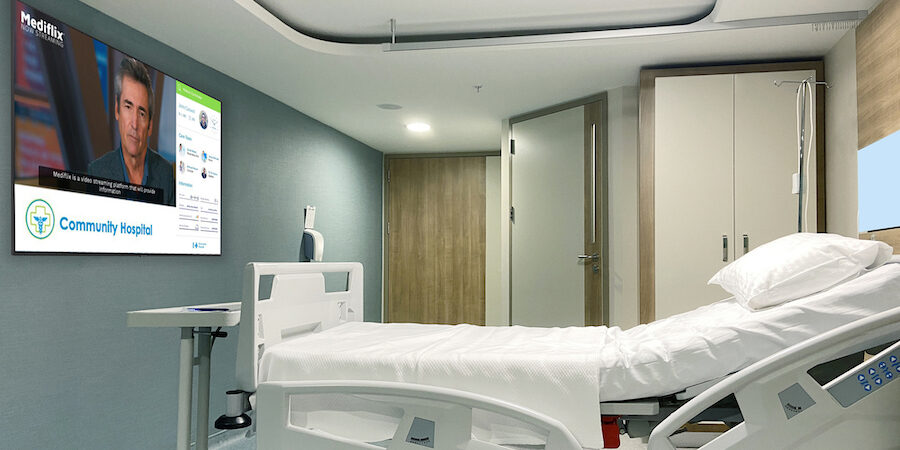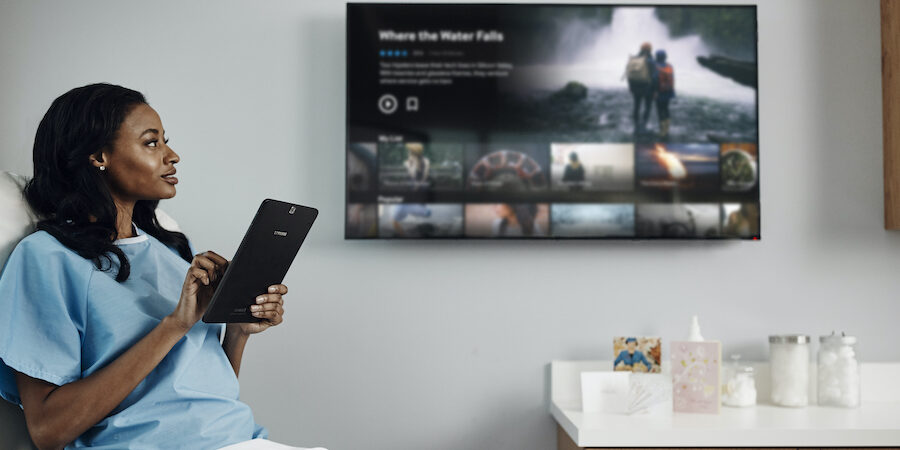Hospitals and healthcare clinics face a difficult challenge: How can they provide an immediately welcoming, comforting atmosphere in a place where many people arrive in pain and feeling anxious?
To improve the patient experience, hospitals and healthcare clinics depend on clear, accessible communication — which also promotes more positive health outcomes, and improves visibility for the organization’s brand. Today, the most effective and efficient way to communicate important real-time healthcare information is through digital signage.
Here are some applications and benefits of using healthcare digital signage solutions in hospitals.
1. Guide guests to their destinations
Hospitals are big, busy places, and they can be intimidating to navigate, especially when a patient is trying to get to an appointment on time. Busy healthcare providers are often stopped and asked for directions. This takes up valuable time, which impairs efficiency and increases cost.
Digital wayfinding signage with touchscreen capabilities allows visitors to get their own directions, customized for exactly where they need to go. Self-service wayfinding frees up hospital staff from directing traffic .
Samsung’s touchscreen displays can convey visitor information clearly and directly on a responsive interactive screen, while the Edge-Lit LED Stretched Widescreen SHR series provides a wide view visible from all angles, all hours of the day. These displays act as beacons for patients and staff alike. And when paired with a dynamic content management system such as MagicINFO, some displays can be updated instantly with the most up-to-date information.
Self-service kiosks in lobbies or waiting rooms allow patients to check into their appointment with ease and use an interactive map to find their healthcare provider’s office.
2. Deliver personalized patient care
Patient education and engagement are top priorities for hospitals. The more that patients understand their health needs and feel committed to getting well, the better health outcomes their care team can deliver. In recent years, hospitals have been placing greater emphasis on patient-centered care and shared decision making — with the benefit of improving the patient experience and reducing readmissions.
Digital whiteboards reimagine the traditional patient room. Traditional paper bulletins and dry-erase boards require constant manual updates during the patient’s stay. Replacing these inefficient solutions with digital displays makes it easier to personalize and update patient information, such as their most recent vital signs, their room’s phone number and the names and photos of their care team.
Patient rooms with tablets and TVs allow patients a more comfortable way to watch relevant educational videos and learn more about their scheduled procedures. It also lets them relax with their favorite shows and movies.
Two new TVs further optimize the patient viewing experience and elevate care:
- The HCU7030 series Crystal Hospital TV, was specifically designed for healthcare settings
- The HCF8000 model is suitable for healthcare and hotel settings.
Both have an integrated pillow speaker interface, facilitating patient audio privacy and reducing noise. Because they are WebRTC (real-time communication) ready, they support the quick addition of videoconferencing, which enables telehealth.
Moreover, by integrating the hospital’s system of electronic health records (EHRs) to the Interactive Patient Care (IPC) solution, the TV can give patients on-demand access to their test results, treatment plans, daily schedule and other medical data.
Create the patient room of the future — today
Explore key technologies for enhancing patient experience and care while supporting staff. Download Now
3. Reduce waiting room anxiety
No one likes to wait, but it’s even harder when you’re ill or waiting for a loved one to come out of surgery. Waiting room information screens can alleviate some of that anxiety by displaying the expected wait time and providing engaging content that’s both distracting and educational.
In surgical waiting rooms, digital signage can share status updates with family, using assigned numbers rather than names to protect patient privacy. Family members can see exactly when their loved one goes into the operating room, how long they’re in there and when they’ve been moved to recovery. Updated in real time, this signage eases anxiety for the patient’s family and allows hospital staff to focus on providing the best possible care.
With Samsung’s Edge-Lit 4K LED Interactive QMR-T Display or the 4K UHD Standalone QBR series, guests can track their loved ones’ status and location in crystal-clear resolution. Waiting room signage can also show visitors local information about nearby restaurants, news, traffic and weather.
4. Communicate with visitors in real time
Hospitals have important information to communicate with patients and visitors — whether it’s urgent safety announcements, recommendations or tips, hospital services and events or general wellness awareness.
The “good old-fashioned” way of fliers and bulletin boards tends to be messy and ineffective. Information quickly becomes outdated, and important announcements often go unnoticed in a sea of paper.
Digital signage solutions allow hospitals to be more strategic about what information they share — and when and where they share it. Information is easy to update digitally, and in emergency situations, administrators can push real-time safety alerts. In the case of an infectious disease outbreak, when the CDC is regularly updating their safety protocols and guidelines, digital signage can quickly communicate the latest information with visitors and staff.
Lobby displays can also help tell your organization’s story. Doctor profiles, patient stories and testimonials playing on dynamic displays inspire confidence in the facility. The same displays can inform patients about the available amenities, innovative medical practices and answers to other common questions.
In the hospital cafeteria, digital signage enables fast and easy menu updates. Rather than writing on chalkboards or reprinting fliers, staff can instantaneously update the daily specials, remove sold-out items, alter prices and make other adjustments on the fly.
5. Celebrate your donors and increase revenue
To honor the people who make the hospital’s work possible, Samsung’s The Wall can showcase your top donors on a larger-than-life banner that guests see as soon as they walk through the front door. The modular, immersive microLED display commands attention and helps generate more donations to your facility. For an out-of-the-box solution, The Wall: All-in-One comes in set sizes and simplifies installation with pre-assembled mounting brackets and background plates.
Displays can bring money to the hospital by promoting your services, affiliate clinics and the gift shop — or the cafeteria’s daily lunch special. Hospitals can build brand visibility by announcing any recent awards won by the care team, or profiling top doctors on staff. You may even opt to rent advertising space on your displays, fostering mutually beneficial relationships with local businesses.
6. Share information across hospital staff
Doctors and nurses can use digital signage to quickly share critical patient information without the need for paper charts or bulky folders. A small patient information screen positioned outside the patient room, for instance, may list the patient’s allergies and other applicable health warnings, such as fall risk or quarantine. There’s lower risk of staff error, while maintaining HIPAA compliance.
Nurses’ stations can use digital signage to inform staff about who’s currently on duty, upcoming shift schedules and which nurses should be matched with specific patients based on language preferences. Outfitted with widescreen monitors, nurses’ stations can become collaboration hubs, with instant access to digital patient records and notes on nurses’ station signs.
7. Increase the speed of diagnosis
One of the top benefits of digital signage for hospitals is the potential for more efficient patient diagnosis. Widescreen monitors offer a larger canvas, so doctors and nurses can more quickly review all sorts of information, from X-rays to EHRs. Enhanced resolution helps physicians review X-rays, CT scans and other visual information with greater accuracy.
Physicians save time they would have spent switching between windows and rummaging through their notes, allowing for faster diagnosis and improving the overall patient experience.
Meanwhile, interactive whiteboards allow physicians to digitally annotate patient imagery. With a few taps, these annotations can be downloaded and sent to the patient or to other members of their care team. They can also be used for collaboration. For example, the Samsung Interactive Pro is like a paper flip chart, but digital. It creates a real-world writing experience with both pen and brush mode.
These are just some of the potential use cases and benefits. Across a healthcare facility, digital signage offers patients — and their care teams — easy access to up-to-date information, for more efficient care and greater peace of mind. The result? An enhanced patient experience, increased efficiency and greater clinician satisfaction.
As you plan a digital signage rollout for your hospital, you have an array of options for Samsung healthcare display solutions, all of which can improve treatment outcomes, interlink medical team communications and bring your brand to life. If you’re on the fence about adding displays to your facility, learn how digital signage is easing pain points and transforming clinician and patient experiences in this free guide.









